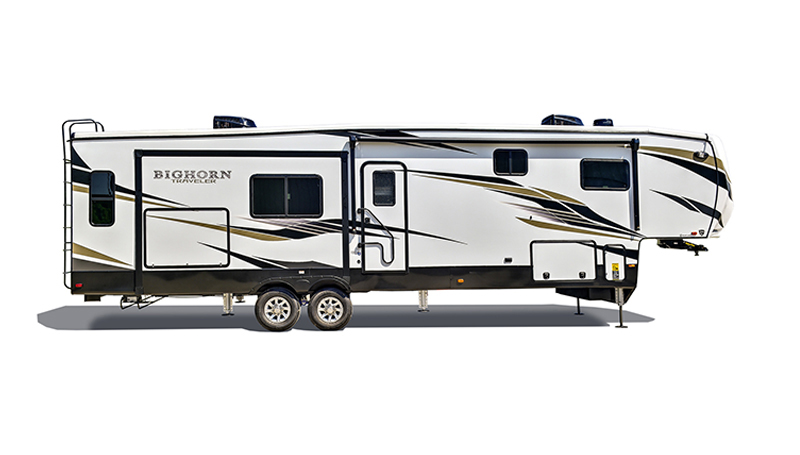Understand the different ratings and weights
The first and most important step is to make sure your tow vehicle is capable of safely towing your fifth wheel. You’ll probably hear or read phrases such as Gross Vehicle Weight Rating, Unloaded Vehicle Weight or dry weight and hitch or tongue weight. Knowing what these ratings and weights mean is very important. Be sure to have your tow vehicle and RV dealer show you where these weights are listed and have them explain each one. Here’s a quick list of definitions to help you get started:
— Gross Vehicle Weight Rating (GVWR) - The maximum permissible weight of a vehicle when fully loaded. There is a GVWR for both your tow vehicle and your fifth wheel. The GVWR is stated on the Federal Certification Label which for the tow vehicle is found inside the driver’s door and on the front left side of a fifth wheel.
— Gross Axle Weight Rating (GAWR) – The maximum permissible weight allowed on an axle(s) when fully loaded.
— Gross Trailer Weight (GTW) - The total weight of your RV including all fluids, passengers and cargo.
— Unloaded Vehicle Weight (UVW) or Dry Trailer Weight - The total weight of your RV without any fluids, passengers or cargo.
— Cargo Carrying Capacity (CCC) - The maximum amount of weight you can load onto your RV, including all of your gear, water, gas, and waste. The CCC is stated on a label which is located on the forward most entry door of your fifth wheel.
— Hitch or Tongue Weight - The amount of the RV’s weight that is transferred to the tow vehicle’s hitch when the two are connected; for fifth wheels, this should be approximately 20-25 percent of the GTW.
Know your towing capacity
We put towing capacity as its own tip because it is critical you know this in order to safely tow your fifth wheel. Towing capacity is the maximum amount of weight your specific tow vehicle can safely tow as determined by the manufacturer. Please consult with your tow vehicle’s dealer for more information about the specific ratings of your tow vehicle. The weight of your RV should never exceed your rated tow capacity. To play it safe, the weight of your RV should equal about 80 percent of your tow capacity. Terrain can make a difference in how your vehicle handles the weight and you don’t want to be at your max while trying to tow through the mountains. Exceeding your tow capacity, or towing more weight than your vehicle is rated for, can be extremely dangerous. Plus, the closer you get to your vehicle’s tow capacity, the more stress you’ll put on your transmission and braking system.
Memorize the height and length of your fifth wheel
Another critical thing to know is your fifth wheel’s total height and length (aka its clearance). When measuring the height of your RV, make sure you also include any air conditions or other fixtures on your roof. Knowing your length is important for both turning and ensuring that you can fit into campsites. Keep in mind that some campsites have a maximum length requirement. In our experience, we haven’t had any issues with clearance on major freeways or interstates. However, some backroads and even campground entrances can have low hanging signs, wires, even tree branches. Always keep an out for low clearance signs and never be afraid to ask a campground or RV park about the best roads for entering and leaving. Keep a list of these dimensions in the tow vehicle for easy reference when traveling.
Practice in an empty parking lot (and other tips from a semi-truck driver)
You might be wondering how we learned to tow such a large fifth wheel. Luckily, Darren has 10 years of experience driving fire trucks and Amanda’s dad drove semi-trucks for over 30 years. We’ve learned some really helpful towing and maneuvering tips from both of them. Here’s what they had to say:
— Always practice defensive driving, especially when on the freeway. Try to anticipate what the other cars around you are going to do. For example, do you notice a slowdown up ahead but the car in front of you isn’t slowing down yet? Anticipate that the car may slam on their brakes and proactively start to slow yourself down. This is also a good rule whenever you’re towing a fifth wheel—leave extra distance between you and the car in front of you.
— Remember that you can’t move or change lanes as quickly as the other vehicles on the road, so give yourself extra time and be very aware of your surroundings. You can always add side view mirror extensions to improve your visibility.
— Head to an empty parking lot to learn the turning radius of your fifth wheel. Practice turning both left and right, as well as backing up.
— Start driving short distances first to gain some confidence. Once you feel more comfortable towing, gradually progress to longer distances and bigger trips.
— If you see a truck driver at a gas station or rest stop, ask them for any tips or advice!
Remember to be patient
A final tip when towing is to stay patient. Never get in a hurry, as this is usually when unwanted experiences can happen. You can ensure the safety of your family and others by not being in a rush. Let the travel day be a part of the journey and not just a way of getting to your final destination.







